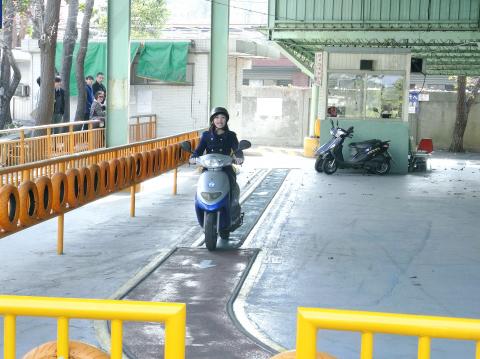The Directorate-General of Highways (DGH) plans to increase the difficulty of the driver’s license test for motorcycles, adding that soon, car driver’s licenses would no longer be valid for operating lightweight scooters.
Vehicle Division Director Lin Fu-shan (林福山) said that the agency decided to reform the driver’s exam to enhance the defensive driving skills of motorcyclists.
Statistics from the DGH showed that 1,819 people died in A1 category traffic accidents last year, with more than 50 percent of victims who died within 24 hours being motorcyclists.

Photo provided by the Directorate-General of Highways
Lin said the number of possible questions to be used in the test would increase from 634 to 1,606, including 682 multiple-choice questions and 924 true-or-false questions.
The test is also to be available in eight different languages: Chinese, English, Japanese, Vietnamese, Indonesian, Thai, Cambodian and Burmese.
Lin said that 50 questions would be randomly selected from the question bank. Previously, only 40 questions appeared on the license test, which most exam takers can finish within five minutes.
The measure is to be implemented on July 1.
Lin said that the agency is studying the use of test questions that put test takers in different scenarios and ask them to identify the best course of action under those circumstances, adding that this type of question would be added to the study questions in January next year.
Meanwhile, people holding a car driver’s license will no longer be able to use the license to ride scooters with engines of 50cc or smaller, Lin said, as motorcyclists will only be able to secure licenses after passing both written and road tests.
Lin added that the new policy would take effect by the end of this year after the amendment of relevant regulations is complete. Those who disobey the regulation would face fines of between NT$1,800 and NT$3,600.
Lin said that the regulation would apply only to people obtaining a driver’s license after the policy takes effect. Drivers who get their license before the end of this year can still ride lightweight scooters with their license, he said.
DGH Director-General Chao Hsin-hua (趙興華) said statistics show that the main causes of traffic accidents are drivers failing to pay attention to the traffic situation ahead, yield to vehicles with the right of way and follow traffic signs, as well as drunk driving.
He said that the motorcycle license road test would include four new items, including making a hook turn if they need to turn left, changing lanes, negotiating right-angle turns and stopping at intersections. In a hook turn, motorcycles ride to the right side of the road they want to turn on and wait in a designated spot.

Beijing could eventually see a full amphibious invasion of Taiwan as the only "prudent" way to bring about unification, the US Department of Defense said in a newly released annual report to Congress. The Pentagon's "Annual Report to Congress: Military and Security Developments Involving the People's Republic of China 2025," was in many ways similar to last year’s report but reorganized the analysis of the options China has to take over Taiwan. Generally, according to the report, Chinese leaders view the People's Liberation Army's (PLA) capabilities for a Taiwan campaign as improving, but they remain uncertain about its readiness to successfully seize

HORROR STORIES: One victim recounted not realizing they had been stabbed and seeing people bleeding, while another recalled breaking down in tears after fleeing A man on Friday died after he tried to fight the knife-wielding suspect who went on a stabbing spree near two of Taipei’s busiest metro stations, Taipei Mayor Chiang Wan-an (蔣萬安) said. The 57-year-old man, identified by his family name, Yu (余), encountered the suspect at Exit M7 of Taipei Main Station and immediately tried to stop him, but was fatally wounded and later died, Chiang said, calling the incident “heartbreaking.” Yu’s family would receive at least NT$5 million (US$158,584) in compensation through the Taipei Rapid Transit Corp’s (TRTC) insurance coverage, he said after convening an emergency security response meeting yesterday morning. National

Taiwan has overtaken South Korea this year in per capita income for the first time in 23 years, IMF data showed. Per capita income is a nation’s GDP divided by the total population, used to compare average wealth levels across countries. Taiwan also beat Japan this year on per capita income, after surpassing it for the first time last year, US magazine Newsweek reported yesterday. Across Asia, Taiwan ranked fourth for per capita income at US$37,827 this year due to sustained economic growth, the report said. In the top three spots were Singapore, Macau and Hong Kong, it said. South

Taiwan is getting a day off on Christmas for the first time in 25 years. The change comes after opposition parties passed a law earlier this year to add or restore five public holidays, including Constitution Day, which falls on today, Dec. 25. The day marks the 1947 adoption of the constitution of the Republic of China, as the government in Taipei is formally known. Back then the Chinese Nationalist Party (KMT) governed China from Nanjing. When the KMT, now an opposition party in Taiwan, passed the legislation on holidays, it said that they would help “commemorate the history of national development.” That